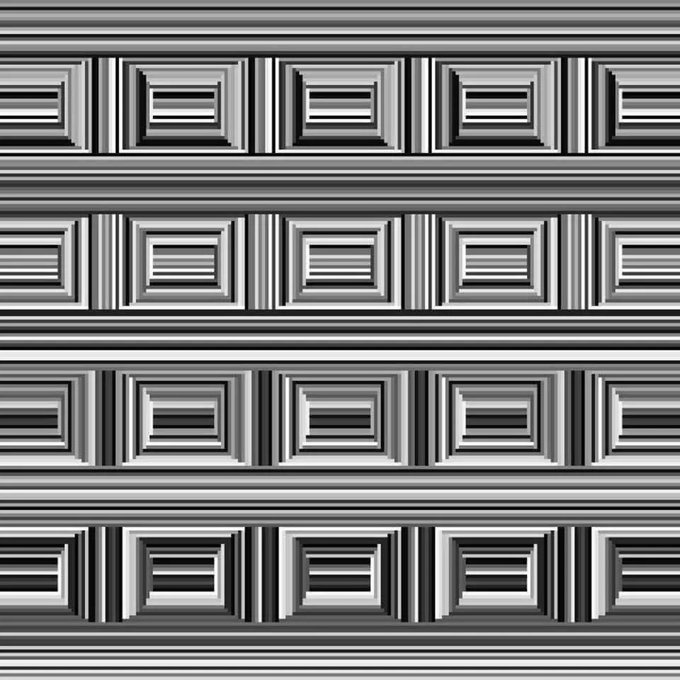Optical Illusion Can You Spot 16 Hidden Circles An intriguing optical illusion featuring 16 concealed circles continues to perplex viewers worldwide, demonstrating the remarkable complexities of human visual perception. This phenomenon, scientifically known as the “Coffer Illusion,” reveals fundamental insights into how our brains process visual information.
The Science Behind Visual Deception
Understanding the Coffer Illusion Mechanism
Created by Stanford University psychologist Anthony Norcia, this illusion presents a pattern of intersecting black, white, and gray lines that most observers perceive as rectangular shapes. However, embedded within this geometric design are 16 perfectly formed circles that remain virtually invisible to many viewers, even when they’re aware of their existence.
According to NIH visual neuroscience research, our visual system demonstrates inherent biases toward detecting corners and angles rather than curved shapes. This recognition earned the illusion finalist status in the prestigious 2006 Best Illusion of the Year Contest.
Optical Illusion: Can You Spot 16 Hidden Circles in This Image?

Neurological Basis of Shape Recognition
Research from the National Institute of Health’s Neuroscience division explains that visual perception involves complex neurobiological mechanisms underlying vision and visual perception in both humans and animal models. Our brains prioritize rectangular patterns because evolutionary adaptations favored recognizing potential threats and navigating environments with angular structures.
Why Rectangles Dominate Our Perception
Evolutionary Programming of Visual Recognition
The human visual cortex exhibits a pronounced preference for corners and edges, creating what neuroscientists describe as increased “salience” for angular shapes. When examining the Coffer Illusion, our neural processing immediately focuses on rectangular patterns because corners appear brighter and more prominent than the subtle curves forming the hidden circles.
The Role of Daily Visual Experience
Our constant exposure to rectangular objects—computer screens, buildings, signage—significantly influences how we interpret ambiguous visual information. This learned bias means that when confronted with the illusion, most viewers default to seeing rectangles because this interpretation aligns with their accumulated visual experience.
Cognitive Mechanisms and Attention
Limitations of Human Visual Processing
The illusion demonstrates how our attention commits to a single interpretation of ambiguous stimuli. Once viewers lock onto the rectangular pattern, their visual system becomes reluctant to consider alternative arrangements. However, individuals who successfully identify the circles often report they can easily switch between both interpretations afterward.
Techniques for Circle Detection
Effective Viewing Strategies
Visual perception experts recommend focusing on vertical lines between apparent rectangles rather than horizontal elements. Another successful method involves slightly defocusing the eyes or viewing from different distances, similar to Magic Eye stereogram techniques.
Research Applications and Modern Relevance
The Coffer Illusion provides crucial insights for developing artificial intelligence systems and computer vision algorithms. Understanding human perceptual limitations helps researchers create more robust AI systems capable of interpreting challenging visual data.
Educational institutions utilize this illusion to demonstrate cognitive biases and introduce complex neuroscience concepts. The phenomenon serves as an accessible gateway to understanding normally invisible processes governing our visual interpretation of the world.
Visual Perception Data Analysis
| Perception Factor | Percentage of Viewers | Response Time (seconds) |
|---|---|---|
| See rectangles only | 85% | Immediate |
| Identify circles immediately | 5% | 0-3 |
| Find circles after instruction | 60% | 10-30 |
| Cannot see circles at all | 15% | N/A |
| Can switch between both | 25% | Variable |
Optical Illusion Answer
Frequently Asked Questions
Q: Are there actually 16 circles, or is this just a visual trick?
A: Yes, there are genuinely 16 circles embedded in the pattern, formed by the line intersections.
Q: Why can some people see circles immediately while others struggle?
A: Individual differences in visual processing, attention patterns, and past experience affect interpretation speed.
Q: Does inability to see circles indicate vision problems?
A: Not at all – this is completely normal and demonstrates typical brain visual processing patterns.
Also Read:-Optical Illusion Challenge: Spot 3 Differences in 5 Seconds

